By most accounts, Kathmandu is a medieval city nestled between two main rivers called Bagmati and Bishnumati. Also known as Kantipur, it is the largest of the three major cities in the Kathmandu valley, the other two being Patan (Lalitpur) and Bhadgaon (Bhaktapur). Kathmandu is the capital and cultural hearth of Nepal, a country invariably viewed by Westerners as a Shangri-La, an alluring piece of imaginative geography. Imaginative geography is more than a mental map with its own distorted lines and vexed contours. It is more than a cultural landscape with definable characteristics that are produced and reproduced through a series of interactions between people and their physical environment. It is a distinct creation of what Bishop calls “cultural fantasy-making”— a place filled with fantasies, a place of mythical proportions.2 It is, in other words, a cultural sanctuary imagined to be sacred no matter how “strange” and “bewildering” it may be. But Kathmandu is choking, today, on the exhaust of its own modern march: environmental pollution. So severe is the problem of pollution that it not only poses a serious threat to the very tourist industry that sustains its march of modernity, but also to public health.
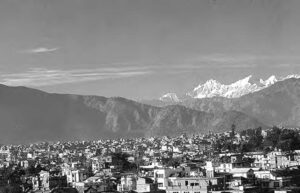
Inventing Shangri-La
Tibet, of course, was the ultimate Shangri-La until its political demise in the late 1950s. James Hilton’s Lost Horizon left little doubt about it.3 In the novel, he discovered Tibet, not the one that is rugged and unforgiving, that Tibetans lived and knew as an integral part of their daily reality, but the Tibet that Westerners imagined. Not only did Hilton introduce the word “Shangri-La” into the English lexicon, he also popularized a vision of utopia, an imaginative cultural landscape superimposed on the actual geography of Tibet, thus elevating it to the zenith of sacredness, a world where the axis mundi connected heaven and earth, where time was frozen and space unbounded, where brutal forces of nature and treacherous antiquity turned into a scene of serene beauty and youth, where realities were invented through imaginations and then authenticated through regurgitated travel accounts and postcards, poems, and letters to the dear ones back home. Immensely popular in both Britain and the United States, Hilton’s novel was made into a movie in 1937, thus mobilizing for public (mass) consumption the captivating vision of utopia that Shangri-La exuded.4
Sacred places are, however, paradoxical. They engender a sense of both fear and fantasy, terror and tranquility. They are places of awe and worship as they possess what I call “raw beauty” that defies depth as well as simple description. Once their paradox is resolved through the production of imaginative geography, the fear and darkness of such places yield to hope and healing, thus releasing a stream of fantasies. They become a Shangri-La—“a place of loss, of self discovery, of transcendence, of ennui.”5
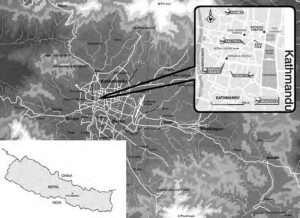
It was in this tradition of producing imaginative geographies, places of mythical proportions, that the Shangri-La of Nepal was carved out. It is plausible to argue that Nepal was produced as a place of mystical beauty to fill the void left by the loss of Tibet’s Shangri-La or to satisfy what Bishop calls Western “erotic, imagining compulsion.” When Tibet was annexed by China in 1959, its borders were effectively closed; its spirituality and levitating power were suddenly grounded. “By comparison with its fullness in the past, Tibet as a place was left vacant of spiritual significance
to Westerners—except, that is, for a few devotees.”6 After all, Nepal was the closest “thing” to Tibet, both geographically and spiritually. Moreover, freshly emerging from the darkness of Rana autocracy in 1951, Nepal vaulted into the world of modernity, ready to welcome Westerners and Western values with open arms.7 Nowhere was this imaginative geography played out more lusciously than in its gravitational center: Kathmandu. To many, Kathmandu was Nepal imbued with mysticism, where Western cultural fantasy-making could readily be superimposed on its actual geography to produce a sacred landscape, a place of loss and self-discovery and self-recovery. The rapid unfolding of events after 1950 further solidified its Shangri-La image. For instance, Sir Edmund Hillary and his Sherpa guide, Tenzing Norge, conquered Mt. Everest in 1953. This not only paved the path for the rapid growth of Western mountain expeditions to Nepal, but also laid the foundation of its modern tourist industry. Even the illusory image of Yeti proved to be fascinating and mystical enough to arouse Western “imagining compulsion.” Then, starting in 1962, American Peace Corps volunteers arrived year after year, followed by waves of Western hippies who came in search of hashish and hiatus from their stale suburban lifestyles. In the sanctuary of the Nepali Shangri-La, they found both.
Along came Cat Stevens, who took the city’s imaginative geography to a newer height in his famous song, “Katmandu,” and the city, where time was still and bewildering, was eager to hold him down. A couple of years later, Bob Seger traced Stevens’s Shangri-La pilgrimage. In a tone similar to Stevens’s, his song “Katmandu” also projected the city as a place of spiritual healing and reprieve from the mire of American materialism. To countless Westerners, Kathmandu was the place of self-discovery and self-recovery, where one found the meaning and balance of life as well as the path to eternal wisdom. It is precisely this image of Tibet and Nepal that even The Wall Street Journal has masterfully exploited in a recent ad to promote itself as a source of another type of balance and eternal wisdom: business wisdom.8
KATHMANDU
A Paradoxical Shangri-La
As noted above, Kathmandu was a medieval city with a quaint look. Similar to the tradition of National Geographic that routinely presented non-Westerners as closely blended into nature with
bare breasts, or as exotic and colorful with smiles fixed on their faces, Westerners configured even native residents and their lifestyles into the vast vista of their imaginative geography of Kathmandu. Like other imaginative geographies, Kathmandu was a paradox, however, made of juxtaposing pictures—one immersed in the daily reality and experience of its residents, and another invented in the fantasy-filled imagination of Westerners.

Newari (Jyapu) sari and
carrying a child on her back. PHOTO BY NANDA R. SHRESTHA
Although chained to its past and deeply shrouded in its medieval veil, the city was restless in its quest for a modern future. It radiated an aura of charm and challenge, mysticism and mystery, with few barriers imposed against outsiders to penetrate its mystical depth and explore its mystery. Kathmandu was a city where its timeless past was vividly stored in its shapeless present, where its ubiquitous ancient temples, packed houses, and narrow streets with countless shops and crowded conditions formed the core of its live cultural curios and bewildering beauty: an instant museum. Space was tight as if it was distance-less, yet getting around the city was no easy chore. The city looked chaotic and disorderly and difficult to navigate, yet Westerners found it uniquely titillating as they could freely romance with its pristine qualities. For some, a journey to the city was like traveling back in time to medieval days, whereas it was, for others, a fantasy land, an escape into profound simplicity and eternal happiness, unencumbered by technological advances and onslaughts. So there was room for virtually every Western tourist to quench whatever craving s/he had.
The story has taken a new twist today. “Hippies” are long gone, but other Western tourists continue to come: over 136,000 in 1990.9 The tourist industry has matured.10 The city is a lot more glittery than one could ever imagine only a couple of decades ago. The past seems to be fading fast, and the future is fuzzy. Yet the city remains a paradox. For instance, glaringly juxtaposed against its countless ancient temples are its fancy hotels with modern amenities, including four casinos all managed by Richard Tuttle, an American casino king of Nepal. While the temples paint for Westerners a testimonial picture of Kathmandu’s past artistic glory, modern hotels offer them great comfort with impeccable service that reaches far beyond any expectation of their nostalgic yearning for good service that is rare in most Western societies. Western tourists can satisfy almost any urge of their “imagining compulsion”—be it the pleasure of a medieval flight or the grandeur of utopian simplicity—right in the comfort of first-rate hotels.
KATHMANDU
A Paradigm of Pollution
Kathmandu is now experiencing a new paradox: the paradox of modernity. Deeply ingrained in this new paradox is the raging conflict between the bliss of modernity and the blight of modernization that is most acutely manifested in the form of pollution. Unfortunately, as the city’s physical pollution intensifies, the bliss of modernity increasingly surrenders to the blight of modernization. No wonder Shangri-La is sinking fast into the mire of its own modern glory. For a city like Kathmandu that is excessively dependent on Western tourists, the deepening crisis of pollution is like an open Pandora’s Box.
A local garbage collector claims the people of Kathmandu “produce too much garbage.” Just ten years ago, he used to collect half a tractor load of garbage from Kasthamandap (a central part of
Kathmandu) every morning. “These days,” he said, “I have to make two, sometimes three, trips. It is becoming impossible to keep this place clean.”11 A Nepali woman entrepreneur recently sent me an email. “Pollution in Kathmandu,” she sighed, “is taller than Mt. Everest. If a white shirt becomes brown in a couple of hours because of pollution, I wonder how many sediments of this brown thing one can find in people’s lungs. It appears that Nepalis’ life expectancy is going to be shortened by pollution.”
Like many Asian cities, Kathmandu is a typical paradigm of urban pollution, a symbol of modernity gone awry, a fact that any visitor can verify. Tourists are now being advised to carry and wear a mask to avoid inhaling potentially dangerous air pollutants. The air is thick and dirty. Lost in the ongoing debate over its physical pollution, however, is its filthy past. Lack of sewage system facilities in the face of dense housing has historically defined its urban environment. What is different between the pollution of the past and the present condition is essentially a matter of its nature and degree.
PHYSICAL POLLUTION
Past and Present
It is difficult to gain a good understanding of Kathmandu’s present pollution in isolation from its past. With the premise that the past informs the present, let me first offer a brief account of my own observation of the city’s physical pollution in the mid-1960s. I take this approach, not because it is personal, but because it is common as well as convenient; it sets a historical context for its present environmental degradation so we can gain a temporal perspective. As a student from outside the valley visiting Kathmandu for the first time over thirty years ago, I was most struck by its rampant rubbish and air filled with pungent odor. Everywhere there was defecation and urination, even right outside people’s homes. Few public spaces were immune from physical defilement, not even temple grounds where people went almost every morning to worship their favorite deities. I asked myself: how could the residents spoil the very temple ground that they regarded as most sacred? There was little physical separation between the temples and the toilets.
Splattered with human excrements and garbage, virtually every street looked like a dump yard or an outhouse. The whole city stunk like a rotten carcass, especially during the summer monsoon when the rains drenched the streets, magnifying the manifold problem. Yet the residents were nonchalant about such poor sanitation. To those from outside the valley, taking a trip to the city was invariably seen as a voyage to the world of civilization, far removed from mundane rural life. Kathmandu was Nepal. When asked where they were going, rural folks on their way to Kathmandu would routinely say: “To Nepal.” Such was its glow and glory. In reality, however, its physical condition made it look like anything but the world of civilization.
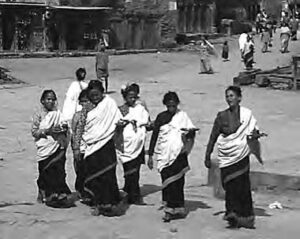
To be sure, people everywhere have affected their environments in one form or another. In fact, the ability to “tame” nature has long been interpreted as a key indicator of technological achievements and human progress. Within the framework of Cultural Geography, cities are the most glaring cultural artifacts of such achievements and progress: the taming of nature. In this sense, Kathmandu is no exception. But the focus here is not on nature-taming per se, i.e., the growth of Kathmandu as a city, as a distinct cultural landscape. Rather, it deals with how its residents over the years have treated what they have created out of the valley’s nature, namely, the city itself and its physical environment. Particularly at issue is its growing pollution.
Kathmandu’s dense population was partly responsible for its physical pollution. But at the core resided the residents’ garbage practice. It is tenable that dense living conditioned their poor attitude toward waste disposal. Regardless of the causal roots, the fact was clear. People would throw garbage, including children’s feces, out the window into the streets without any concern for pedestrians. Since my friends from my hometown Pokhara had learned how to negotiate the physical relationship between the street space and local residents’ waste disposal practice (habit), they warned me not to walk in the middle of the streets in order to avoid being hit by the garbage tossed out the windows. I was, instead, advised to walk close to the houses to minimize such risks. In addition, every so many houses shared a small courtyard-like space, filled with every foul object one could imagine. The house in which my friends lived also shared such a space that could be aptly characterized as a filth disposal yard. The stench from the yard was too strong to leave the window facing the yard open for any extended period of time.
This is a quick glimpse into the past. But what about the present?
Throwing the trash out the window seems to have subsided, along with street defecation. But Kathmandu’s pollution problem has actually worsened. Few would dispute that the problem is partly attributed to the city’s rapid population growth. Its geographical limitation has done little to impede its demographic growth. According to the 1961 census, Kathmandu had a total population of 121,000. Thirty years later, in 1991, the figure had jumped to 420,000.12 Currently, there are probably 500,000 people living in Kathmandu alone, or close to fifty percent of the valley’s total population. The city was already dense, and is now getting denser by the day.
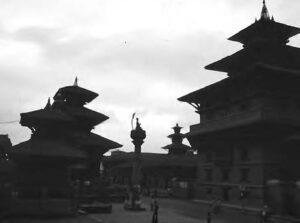
But, again, the population alone can’t explain the gravity of its environmental degradation. No less insidious is modernization, a term that is commonly used to describe Western habit formation among the indigenous people. With modernization— or Westernization as some might call it—has come the ever penetrative culture of consumerism. So there is little mystery to the exponential growth of solid wastes and air pollution in the city. In the wake of growing affluence among what loosely can be called “the middle class,” the culture of consumerism is running amuck. As the per capita income of this small segment of the population has increased many times over the past few years—largely due to the ongoing inflow of foreign aid—the level of consumption has risen dramatically. What we are witnessing is an explosion of consumption for the sake of consumption. What is more, consumption is often defined not only by how much people actually consume, but also by what, and in what form, they consume.13
Back in 1979, I stayed with a Kathmandu family for several weeks. The level of consumption in the family was modest, nothing excessive. Throughout the year they grew various vegetables in their small yard to supplement their food requirements. Meat consumption was limited in terms of both quantity and frequency, rarely more than two times a week. And the meat came straight from a local butcher so it was always fresh. The family had access to a motorcycle that came with the husband’s government job.
Since then, I have stayed with the same family several times during my field research in the country, in 1983, 1984, 1988, and two times in 1994. By 1988 and 1994, a dramatic change had occurred in the family. The husband had resigned from his government post in the early 1980s to launch his own development consulting firm. The amount of food intake was much higher than before. So was material acquisition. Not only had meat consumption become almost a daily affair, but the amount per serving had also increased. Moreover, the form of consumption had changed. The meat now came from some shopkeeper’s cooler, frozen and wrapped in plastic bags with heavy toxic smell. Also frequently used was the processed meat, namely sausages and hot dogs, all prepared with little quality control regarding the use of chemical preservatives. In place of growing vegetables, the garden was filled with flower plants. As a definite sign of prosperity, they had acquired two motorcycles and a used car from an American expatriate.
But what is the relevance, one may ask, of this story? It is relevant because it is a microcosm of the changing nature of the city’s environmental crisis. It is symptomatic of the broader pattern that the city’s pollution is no longer simply a matter of solid waste production from human excrements and other objects, most of which were at least biodegradable. Today the plot has expanded as it is largely scripted in excessive consumption, use of plastic and other non-biodegradable wastes, and the growth of vehicles and industrial pollution. Further complicating these factors is, of course, the persistence of residents’ callous disposal of wastes.
Apart from the simple fact that increased consumption means increased wastes, the long established local tradition of recycling has declined. Nepali people, until fairly recently, were far ahead of most Western societies in their practice of recycling, which kept solid waste production in check. Since not too many consumer goods were readily available in the past, even the rich were quite prudent in using and reusing what they already had. The practice has witnessed remarkable declines over the past two decades. Now that the rich can easily obtain packaged and imported goods, they see little need for recycling. Faced with the peer pressure to avoid all manifestations of their poverty, even the poor are increasingly abandoning their venerated practice of recycling. In other words, so distorted is the whole notion of development in Nepal that wasteful consumption or riding the tidal wave of consumerism has become synonymous with the values of modernity.14 It is, therefore, no surprise that the declining level of recycling has resulted in the increasing amount of garbage production.
Ironically, recycling is now seen as a form of social status devaluation. Until a decade or so ago, merchants diligently saved old newspapers and magazines to use them later as wrappers or to make small paper bags for their customers’ use. Old bottles, tin cans, and other containers were used and reused time and again. Today, not only are they routinely discarded, but they are replaced by
omnipresent nonbiodegradable plastic bags. So all those newspapers, once readily recycled, are now additional pieces of solid waste on sidewalks and streets. And, of course, all those nonbiodegradable plastic bags, an invention of convenience, further add to Kathmandu’s problem of pollution and waste disposal.15
In essence, the old habit of carelessly throwing garbage out the window has now been replaced by the open disposal of everything people cannot or do not consume directly. Albeit Kathmandu’s per capita production of wastes may be no more than a mere fraction of what is produced in the United States and other advanced countries, the city does generate enormous garbage for its size, especially in light of limited disposal facilities. According to Becker, its daily average per capita production of garbage in 1978 was estimated to be 0.25 kilogram. The figure had jumped to almost 0.60 kilogram by 1990. Becker further notes that since 1990 the rate of waste generation has increased another forty percent.16 This means the current per capita production of wastes is roughly
0.80 kilogram a day. At this rate, the total volume of daily wastes generated by its 500,000 residents comes to 400,000 kilograms or 400 metric tons. For a city with few operational disposal mechanisms, this is an immense load. All free and unencumbered, the streets have become the most obvious and readily accessible disposal sites. As one report succinctly states, “Stagnant sewers, mounds of solid wastes, open-air latrines and drinking water swarming with bacteria are a (integral) part of the Kathmandu ecosystem” (the parenthetical word added).17
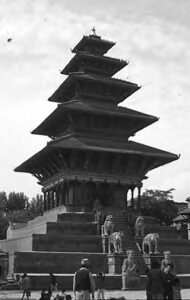
In 1980, a garbage pickup and disposal project was launched. Like all other projects in the country, this too was initiated by foreigners and financed through foreign aid. With the help of Germany, large garbage bins were stationed in different parts of the city. Although this waste management operation at one point hauled away as much as seventy tons of solid wastes a day, the amount was merely a fraction of the total wastes produced in the city.18 During my 1994 visit, I discovered that even this minimal disposal operation had ceased.19 Whatever sense of novelty those garbage bins initially engendered had long worn out. With trash overflowing, those bins themselves had become unsightly landmarks, reminiscent of Kathmandu’s ageless sanitational past as well as present pollution. While the temples dotted the city’s landscape as a reminder of its cultural past, garbage piles formed the mighty mounds of today’s modernization. As grimy Kathmandu increasingly
turns into what metaphorically can be described as one huge landfill, those garbage mounds become ominous of the city’s pending future decays, both environmentally and in human terms.
What has happened to Bagmati (and Bishnumati), a river which Hindus regard as holy, is typical of the fate waiting to deal a debilitating blow to Kathmandu and its parasitic growth. “Sand from its riverbed, hydro-power from Sundarijal, drinking water from Budhanilkantha and Sundarijal, and irrigation water throughout its length—metropolitan Kathmandu takes all these from the Bagmati River. Does the city give anything in return?” asks Dixit sarcastically. “It does—raw sewage generated by hundreds of thousands (of people), untreated effluent from industrial estates, hospital wastes, toxic chemicals and acid from ‘carpet washing’ plants, pesticides and chemical fertilizer leaching from fields, the detritus of cremation ghats.”20 In addition, Bagmati has long been a popular open toilet, where every morning one can see countless human bodies defecating along its banks.
And the story continues. Air pollution has now emerged as the latest threat to stalk the valley of Kathmandu. So gritty is the air that people are choking on the exhaust of one of the most prized fruits that modernization has bestowed upon humanity: mechanized mobility. Few will question its historical role in helping to overcome the friction of distance and inducing spatial economic growth. At the same time, it is a primary source of air pollution. At the global level, motorized transportation is estimated to contribute thirty-two percent of total CO2 emissions; in Kathmandu, it is the principal cause because other sources such as coal burning and industrial pollution are still limited. Irrespective of the cause(s), the city has earned a dubious distinction as one of the most polluted Asian cities. Pollution is so bad that on any given day one can feel the hair getting greasy and heavy within a couple hours of exposure to its physical environment. While the dust has always been a problem, the pollution caused by vehicle emissions is a recent phenomenon, a byproduct of Kathmandu’s unbridled march of modernity.
Certainly, Kathmandu’s physiographic position as a bowl-shaped valley encircled by hills compounds its air pollution. Much of the air pollution generated in the valley remains entrapped within
itself. Again, motor vehicles, most of which are very old, badly out of tune, and running on diesel and leaded gas with no emission controls, are the main culprit. Besides their numerical explosion,
there are, one vehicle parts merchant explained, two other factors exacerbating the city’s air quality: the use of petrol mixed with kerosene (which boosts dealers’ profits) and the overloading of commercial vehicles such as buses, trucks, and tempos (three-wheeled vehicles). This latter problem is further aggravated by the city’s undulated terrain as it places additional pressure on the already overloaded engines. Whenever they climb even a slight slope, they belch out so much dark smoke that it can temporarily obstruct one’s visibility.

the growing use of motorized vehicles. PHOTO BY NANDA R. SHRESTHA
Until two decades ago, Kathmandu enjoyed no more than 10,000 vehicles. In 1987, nearly 26,000 registered vehicles roamed the valley. The number had climbed to 60,000 by 1992: 22,000 light, 6,300 heavy, and 25,700 two- and three-wheelers. Currently, there are probably 75,000–90,000 vehicles. Himal reports that, “Exhaust from about 30,000 vehicles alone amounts to 22,000 tonnes per year of carbon dioxide, 22,000 tonnes of carbon monoxide (and) 2,000 tonnes of nitrogen dioxide.”21 Simply expressed, the problem of pollution is literally getting out of sight. “November,” remarked Brian Whyte, a long-time observer of Nepali tourism, “used to be the month for mountain watching (for Western tourists), once the morning fog lifted. This past November, there was not a day when the mountains were absolutely clear.”22
Losing Shangri-La?
What we can discern, at one level, from this historical perspective on Kathmandu’s physical degradation, is that it was no Shangri-La to local residents. Notwithstanding its artistic glory, it was mostly a parasitic administrative hub that thrived on the surplus extracted from outside the valley, a city littered with human excrements. In this sense, the rhetorical question of “Losing Shangri-La?” is moot, for there was no Shangri-La to lose in the first place. The whole notion of Kathmandu as a Shangri-La was a typical Western concoction, an imaginative geography laid over this fertile valley, where the traditional mode of life endured despite its urban characters, where the line between city and countryside blurred.
Yet, at the other level, we can’t ignore this image of Shangri-La—and hence the implication of its potential loss—simply because it has been deeply ingrained for four decades and because it has been an important source of both money and misery. Once a pure myth, the image has now become a sort of everyday reality—easily evoked for public consumption. It has been highly commercialized, and hence deeply socialized even among the native residents as part of their own imaginative geography. Nowhere is the commercialization of this image more pervasive than within the tourist sector. While the tourist sector indeed gives Kathmandu’s Shangri-La image its “legitimacy” and “authenticity,” every agent or agency within the sector has at the same time exploited it skillfully as a milch cow, since its very conception in the early 1960s, to bilk Western (and now Japanese) tourist dollars.23
No matter how we assess its Shangri-La image, there is little dispute that Kathmandu has arrived at a critical juncture where its mounting pollution crisis has come face to face with its economic future as well as public health. The situation has gotten so serious that many—both rich and poor—are now beginning to wonder about the city’s looming future. In a tone that casts a heavy shadow of despair and urgency, they ask: Does Kathmandu have a future? Until a decade ago, such a question would have brought a roaring laughter to almost every face. “What a silly question!” people would have exclaimed. Undeniably, the production of Shangri-La through Western imagining brought Kathmandu much prosperity and grandeur of modernity. As modern amenities such as motor vehicles, packaged goods, and flush toilets paralleled growing Western orientation, the city shined brightly. And the march of modernity continues at a galloping pace despite its grimy byproducts called pollution.
This is yet another paradox facing Kathmandu. The fact that people are still furiously clamoring to acquire modern glitters clearly demonstrates how seductive so-called modernization (Westernization) is or can be. After all, it is these glitters that give their owners the bragging right, the right to claim that they have been initiated into the world of Westernization, something that only a privileged few can attain. So while the fire of consumerism continues to burn and spread unchecked, people are now beginning to feel the pain of environmental degradation caused by this very fire. That is why the above question takes on a grim tone, leading some to mourn the vanishing past of Kathmandu. “No future for an urban past,” reflects Tiwari, a professor
of architecture in Kathmandu.24 The message is eerily somber.

Caught in the middle of progress and prosperity led by Westernization on one side and pollution and peril imminently lurking over Kathmandu’s environmental future on the other side, however, is public health. As the valley’s air gets thicker and dirtier and snow-capped mountains disappear behind its soupy horizon like a shadow in the dark, ceasing to serenade the valley with their refreshing evening breeze and majestic panorama, the imaginative geography of Kathmandu that is fascinatingly called Shangri-La will eventually turn brown and crumble. It will simply become another ugly Asian city where the past slips into a distant memory, becoming something of a nostalgia, where the present is hard to bear, and the future seems already aborted even before it is fully conceived. Tourism, the anchor of Kathmandu’s economic lifeline and modern glitters, will suffer greatly, leaving the city gasping for air—clean air, that is. As the problem of air pollution intensifies, public health will face a crisis. While the full picture of this public health problem caused by pollution has yet to emerge—and it is unlikely that its gravity will be apparent soon partly because the crisis is still in its infancy and partly because there are few systematic mechanisms in place to gauge it—few have any doubt about this impending crisis.
For Western tourists, such a demise of Kathmandu may be sad, but not shattering, for they will readily discover or devise another Shangri-La somewhere in a faraway, exotic corner of the world. They have no commitment to any one place; they go wherever they can quench their “imagining compulsion” and deepest fantasies. Well-equipped with both money and mobility, they will always find new fertile grounds to comb and cultivate. But the problem of pollution will not leave with them; it will be left behind.
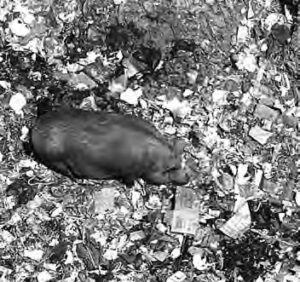
the Bishnumati river. PHOTO BY DR. JOHN METZ
For the local residents, the burden of environmentally degraded Kathmandu will be enormous. To repeat, particularly problematic is its emerging public health crisis. While the economic benefits of modernization have accrued mostly to the rich, its social costs, as related to pollution and public health, bear most heavily on the poor. Endowed with economic means, the rich can afford to treat their health problems caused by pollution or simply retreat to a place somewhere outside the valley where the air is cleaner and the environment greener. Distance is perhaps the least of their problem, for they have access to personal vehicles. They can exercise this choice almost at will. But for the poor? It is an entirely different matter. The poor can neither afford the cost of medical treatment, nor move to a cleaner place away from the valley. They are consequently bound to the very geography filled with pollution, the byproduct of modernization, that wreaks public health havoc on them. So the crisis of public health will be most daunting for those who can least afford to deal with it. As an American friend of mine lamented after his recent visit to Kathmandu, “The environment, I’m afraid, may kill the mountain views, and more sadly, my (Nepali) friends” (parenthetical word added).25 This is perhaps the ultimate tragedy of losing Shangri-La, that is, Kathmandu.
1. This study is based on my personal observations, as well as the data and information collected during my visits and field research supported by grants from the National Science Foundation (1994 and 1988) and the Ford and Rockefeller foundations (1979). I am grateful for the comments offered by two anonymous reviewers and Drs. Ronald Knapp and John Metz. Their comments have proven to be very helpful in refining some of the arguments contained in this article.
2. Peter Bishop, The Myth of Shangri-La: Tibet, Travel Writing and the Western Creation of Sacred Landscape (London: Athlone Press, 1989), 9.
3. James Hilton, Lost Horizon (London: Pan, 1933).
4. Lost Horizon (Columbia Pictures, 1937); Lost Horizon (Columbia Pictures, 1972; remade with Liv Ullman).
5. Bishop, The Myth of Shangri-La, 7–8.
6. Ibid., 240.
7. Nanda R. Shrestha, In the Name of Development: A Reflection on Nepal (Lanham, MD: University Press of America, 1997). Also see Mark Liechty, “Film and Fashion: Media Signification and Consumer Subjectivity in Kathmandu,” Himalayan Research Bulletin 17:1 (1997), 33–38.
8. The Wall Street Journal, August 8 (1997), A11.
9. CBS (Central Bureau of Statistics), Statistical Pocket Book, 1992 (Kathmandu, Central Bureau of Statistics, 1992).
10. David Zurick, “Adventure Travel and Sustainable Tourism in the Peripheral Economy of Nepal,” Annals of the Association of American Geographers 82:4 (1992).
11. Quoted in Suman Basnet, “Urban Voices,” Himal 5:1 (1992), 26.
12. See Pitamber Sharma, Urbanization in Nepal (Honolulu: East-West Center, 1989); CBS, Statistical Pocket Book, 1992; Dennis Conway and Nanda R. Shrestha, “Urban Growth and Urbanization in Least-Developed Countries: The Experience of Nepal, 1952–71,” Asian Profile 8:5 (1980), 477–494; and Tulsi R. Joshi, “Socioeconomic Perspective of Kathmandu, Nepal,” Asian Profile 3:2 (1975), 173–194.
13. See Dipak Gyawali, “A Fate Other than Marginality,” Himal 7:3 (1994), 11–21.
14. Ibid.; Shrestha, In the Name of Development.
15. See Scott Becker, “Solid Waste Management in the Kathmandu Valley,” Himalayan Research Bulletin 17:1 (1997), 39–48; Bhusan Tuladhar, “Kathmandu’s Garbage: Simple Solutions Going to Waste,” Studies in Nepali History and Society 1:2 (1996), 365–394.
16. Ibid., 39.
17. Himal 5:1 (1992), 30.
18. Ibid.
19. The waste disposal operation run with the help of Germany has ceased. However, the Government of Nepal has recently signed a letter of agreement with a private American waste management company to manage Kathmandu’s wastes.
20. Ajaya Dixit, “The Bagmati Scorned,” Himal 5:1 (1992), 25.
21. Himal 5:1 (1992), 30.
22. Quoted in Bijaya L. Shrestha, “Valley Tourism: The Shine is Off,” Himal 5:1 (1992), 20.
23. For a detailed discussion, see Shrestha, In the Name of Development.
24. Sudarshan R. Tiwari, “No Future for an Urban Past,” Himal 5:1 (1992), 5–7.
25. Ed Burgess, Personal Communication (1997). Ed was in Nepal for five weeks (November-December 1997). Here is one observation that Ed made during his taxi ride in Kathmandu:
“As we entered the traffic streams on the road leading from the airport to the center of Kathmandu, my nose was immediately and intensely assaulted by choking exhaust fumes. Old buses and trucks belched black clouds of smoke, and the three-wheeled tempo vehicles belched equal or greater amounts than the buses. Both my wife and I put handkerchiefs over our mouth and nose and tried to breathe as little as possible.” And, on his way to his friend’s house on the far side of Kathmandu, Ed noted: “As I put a mask to my nose and mouth, I continued to look at the streets of Kathmandu. I could find no area that was not littered with plastic bags and bottles, paper and other garbage. Periodically, the litter and garbage was piled high, with wet
dogs and pigs rooting through the most recent deposits.”

